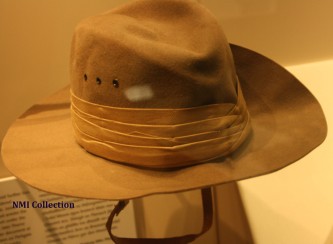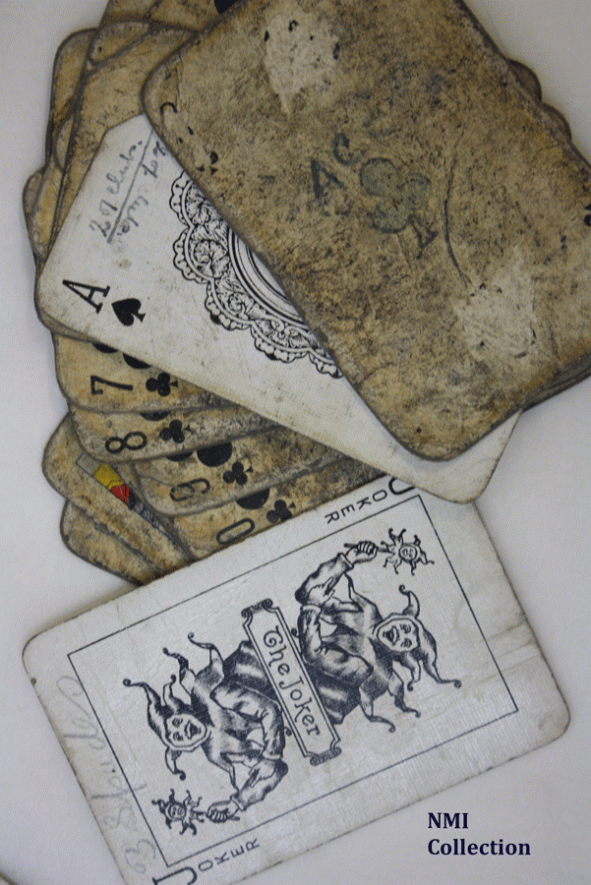In the late 1940s the Irish Volunteer hat and Browning 7.65mm automatic pistol used by Patrick Pearse during Easter Week 1916 were donated to the National Museum of Ireland. The distinctive Australian style hat was missing something vital – its cap badge, with no information on its loss and no indication of its whereabouts. The mystery was solved in 1977 with the publication of Hollywood Hussar by actor John Loder, famous for his roles in The Doctor’s Secret – one of the first ‘talkies’, and King Solomon’s Mines.
Loder was born John Lowe, the son of Brigadier General Arthur Lowe, the commander of the British troops in Ireland from the beginning of the rising, and the officer who took Pearse’s surrender on Saturday 29th April. Loder had followed his father into the army in the early months of World War I, and had seen service in Gallipoli and Egypt. He arrived in Ireland on the Friday before the outbreak of the rebellion to take up his new appointment as Aid-de-Camp to his father. On the outbreak of the rising, he went with Lowe to set up his headquarters in Dublin Castle.
His account of the rebellion is brief, but he describes the fighting in the city centre, the destruction of the GPO and the death of civilians. At the end of the week Elizabeth O’Farrell came to Dublin Castle with a message from Pearse proposing the negotiation of a surrender. Loder wrote the message back to Pearse with the instructions to meet at Britain Street and surrender unconditionally, dictated and signed by Lowe. Loder was with his father at 4pm when Pearse and O’Farrell arrived. The famous surrender photograph shows Loder to the fore, his tall frame slouched slightly, cigarette in mouth.

He describes taking Pearse into detention in a staff car, accompanied by a priest, though his memory of Pearse giving the priest his watch and ring to give to his wife must be a mis-interpretation of the events; Pearse was likely passing his possessions on to his mother or sister. Loder had asked the driver of the car to continue driving past the jail’s gates in order to allow Pearse to finish giving his last messages. In gratitude, Pearse took his hat off, removing what Loder described as the Sinn Fein badge and gave it to him. He ends this recollection saying that he would have liked to have given this memento to the National Museum to join the other items belonging to Pearse, but it was destroyed in his parent’s home during the London Blitz in 1940 to 1941.

After the Dublin rebellion, he was posted to France, fighting at the Battle of the Somme, and was eventually taken prisoner by the German Army in March 1918. After the war he continued his army career at the British Military Mission in Berlin, and on his demobilisation he returned to civilian life, setting up a pickle business in Potsdam, Germany. He turned to acting and moved to America in the 1920s, winning parts in Hollywood and later Broadway, radio and television. Described in his IMDb entry as ‘A tall, debonair, immaculately-groomed British leading man best known for his pipe-smoking chaps’, he lived the Hollywood lifestyle, complete with five marriages, until 1958 when he became a rancher in South America. He returned to London after his last divorce, and died there in 1988.
Many thanks to Michael Lee for telling me Loder’s story and providing me with a copy of his book.
© Brenda Malone. This work is original to the author and requires citation when used to ensure readers can trace the source of the information and to avoid plagiarism.
https://libguides.ucd.ie/academicintegrity/referencingandcitation
Sources and general reading used in the creation of these articles are listed on the Further Reading page.







